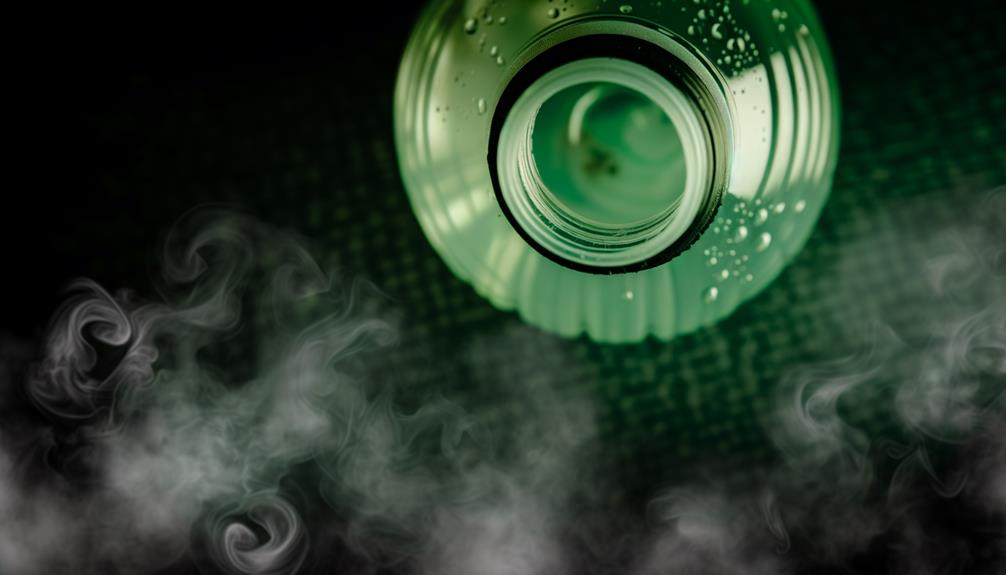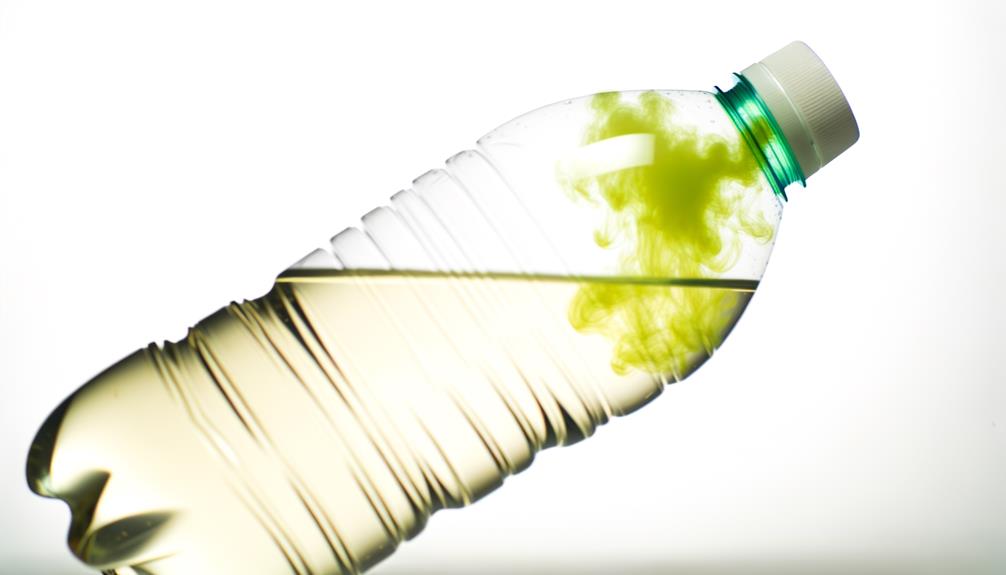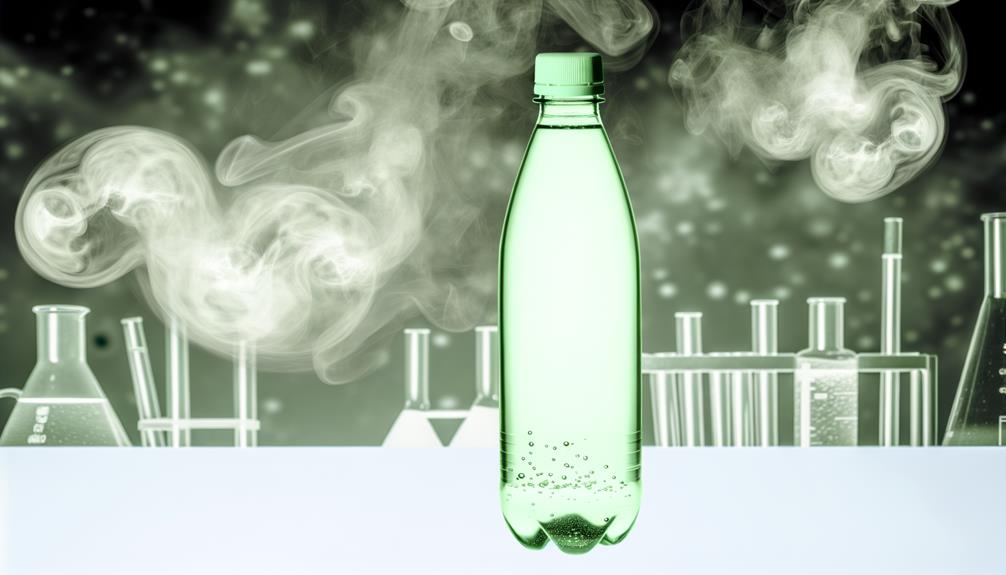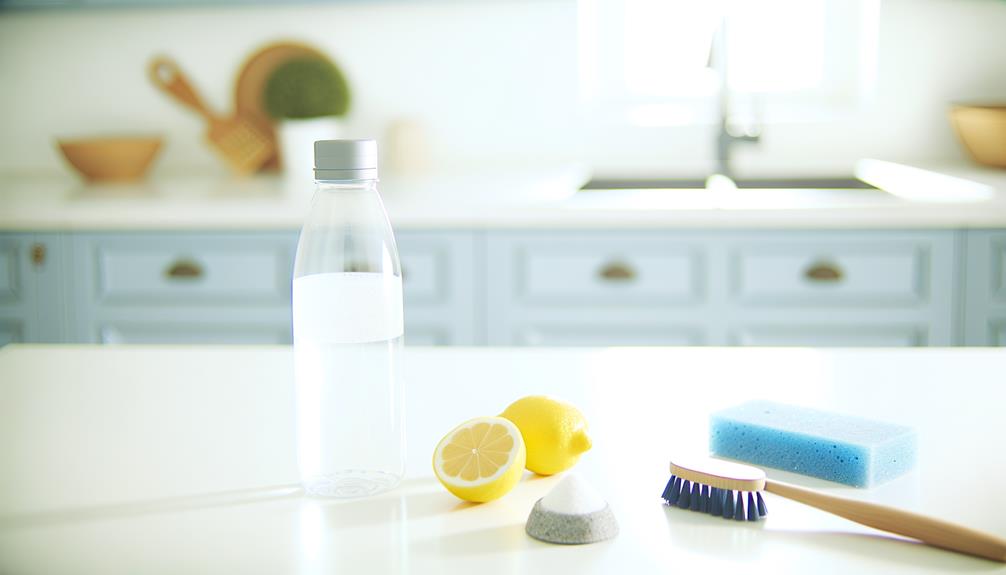Why Does My Water Bottle Smell Like Rotten Eggs
Your water bottle probably smells like rotten eggs due to sulfur-reducing bacteria thriving in moist environments. These bacteria produce hydrogen sulfide, causing the foul odor.
Stagnant water, poor cleaning habits, and storing conditions can exacerbate the issue. Bottles made of materials like polyethylene can retain and even absorb such odors over time.
Contaminated water sources, especially from private wells, can also introduce sulfur compounds. Regular cleaning with vinegar or hydrogen peroxide and proper storage can help reduce or eliminate the smell.
Discover how to keep your water bottle fresh and odor-free with specific cleaning solutions.

Key Takeaways
- Sulfur-reducing bacteria in stagnant water produce hydrogen sulfide, causing a rotten egg smell.
- Poor cleaning habits allow bacteria and sulfur compounds to accumulate, leading to unpleasant odors.
- Certain water sources naturally contain sulfur compounds, which can contribute to the smell.
- High temperatures accelerate bacterial growth and sulfur compound production, worsening the odor.
Bacterial Growth
Bacterial growth in water bottles often leads to the production of sulfur compounds that emit a rotten egg smell. Studies show that various bacteria, such as sulfate-reducing bacteria, thrive in moist environments like water bottles.
When these bacteria break down organic material, they produce hydrogen sulfide, which causes the unpleasant odor. You're not alone in this issue; many people experience it, especially if bottles are left unopened for long periods.
Research indicates that bacteria can multiply quickly, doubling their population in as little as 20 minutes under ideal conditions. To maintain a sense of community and shared experience, understanding this process can help you and others take proactive steps to mitigate bacterial contamination and keep your water bottle fresh.
Poor Cleaning Habits
Neglecting to regularly and thoroughly clean your water bottle considerably contributes to the development of unpleasant odors. Bacteria and mold flourish in moist environments, and a poorly cleaned bottle provides an ideal breeding ground. Studies indicate that the average water bottle can harbor over 300,000 colony-forming units (CFUs) per square centimeter, a significant increase compared to other household items.
| Cleaning Frequency | CFUs/cm² |
|---|---|
| Daily | 1,000 |
| Weekly | 50,000 |
| Monthly | 200,000 |
| Rarely | 300,000 |
| Never | 500,000 |
This data underscores the importance of consistent cleaning habits. A daily rinse and a weekly deep clean using soap and hot water can dramatically reduce bacterial growth, ensuring your bottle remains fresh and odor-free.
Plastic Bottle Materials

Certain materials used in plastic water bottles can considerably contribute to the development of foul odors if not properly managed.
Polyethylene terephthalate (PET), commonly used in disposable bottles, can absorb flavors and odors over time. Studies show that PET bottles can leach chemicals like acetaldehyde, which may produce an unpleasant smell.
High-density polyethylene (HDPE), often found in reusable bottles, can harbor bacteria in micro-scratches, worsening odors. Even Bisphenol A (BPA)-free plastics aren't immune; they can degrade under UV light, releasing odor-causing compounds.
To mitigate these issues, choose bottles made of stainless steel or glass, which are less likely to retain smells and are easier to clean.
Consistent maintenance can guarantee your bottle remains fresh, fostering a sense of community and shared standards.
Contaminated Water Source
While the materials of your bottle play a significant role in odor formation, the water source you use can also be a major contributor.
Contaminated water sources often contain sulfur-reducing bacteria, which produce hydrogen sulfide—a compound known for its rotten egg smell. Studies show that groundwater often harbors these bacteria, especially in wells lacking proper filtration systems.
If your water supply is untreated or comes from a questionable source, it's likely the root of the problem. Data from the Environmental Protection Agency (EPA) indicates that nearly 15% of Americans rely on private wells, which are more susceptible to contamination.
Testing your water for sulfur compounds and other contaminants can help ascertain that the source isn't contributing to the unpleasant odor.
Residual Sulfur Compounds

You might notice a rotten egg smell in your water bottle due to residual sulfur compounds from sulfur bacteria growth. These bacteria thrive in damp, low-oxygen environments, breaking down organic matter and releasing hydrogen sulfide gas, which creates the unpleasant odor. In some cases, you may also wonder why water bottles smell like chlorine—this can happen when residual disinfectants used in water treatment interact with organic materials inside the bottle. Regular cleaning with mild soap and thorough drying can help prevent both sulfur and chlorine-related odors.
These bacteria thrive in contaminated water sources, producing hydrogen sulfide gas.
Studies show that this gas is responsible for the characteristic foul odor.
Sulfur Bacteria Growth
Detecting a rotten egg smell in your water bottle often indicates the growth of sulfur bacteria due to residual sulfur compounds. These bacteria thrive in environments where sulfur compounds are present, leading to unpleasant odors. Understanding why this occurs can help you manage and prevent it.
Anaerobic Conditions: Sulfur bacteria flourish in low-oxygen environments, which can occur if your bottle is sealed for long periods.
Water Quality: High sulfur content in your water supply can contribute to bacterial growth.
Biofilm Formation: Bacteria form biofilms, which are protective layers, making them harder to eliminate.
Cleaning Frequency: Infrequent washing allows residual sulfur compounds to accumulate, providing a breeding ground for bacteria.
Being aware of these factors can help you maintain a cleaner, odor-free water bottle.
Contaminated Water Sources
Contaminated water sources often contain residual sulfur compounds that contribute to the growth of sulfur bacteria in water bottles. When these compounds are present, they provide a nutrient-rich environment for sulfur bacteria.
Studies show that even low concentrations of hydrogen sulfide can cause the characteristic rotten egg smell. It's vital to take into account your water's source, as municipal supplies sometimes have trace amounts of sulfur.
Rural wells are particularly prone to higher sulfur levels due to natural geological formations. Regularly testing your water can help identify contamination early.
Storing Conditions
You've probably noticed that improper cleaning routines and warm storage environments can exacerbate odors in water bottles.
Data shows that bacteria thrive in these conditions, leading to that rotten egg smell.
Additionally, if the water source is contaminated, it can introduce sulfur compounds and other impurities.
Improper Cleaning Routine
How often do you think about the way you store your water bottle when it's not in use?
Improper cleaning routines can lead to bacterial buildup, causing that unpleasant rotten egg smell. Research shows that inadequate cleaning practices can considerably increase microbial contamination.
To guarantee your bottle stays fresh, follow these guidelines:
- Rinse daily: Always rinse with hot water after each use.
- Deep clean weekly: Use a bottle brush and mild detergent to scrub hard-to-reach areas.
- Air dry: Avoid sealing it immediately; let it air dry completely.
Warm Storage Environment
Storing your water bottle in a warm environment accelerates bacterial growth, which can lead to that foul rotten egg odor. Studies show that bacteria thrive between 40°F and 140°F, making warm conditions ideal for rapid proliferation.
When you leave your bottle in places like a hot car or a sunlit room, the temperature can easily rise within this range. This creates a breeding ground for sulfur-producing bacteria, contributing to the unpleasant smell.
To maintain a sense of community and shared responsibility, consider storing your bottle in cooler environments. By keeping it in a refrigerator or a shaded, cool area, you help prevent bacterial growth.
This practice not only enhances personal hygiene but also fosters a healthier, more pleasant shared space.
Contaminated Water Source
When water from a contaminated source enters your bottle, it introduces bacteria and other microorganisms that can produce a rotten egg smell. These microbes thrive in environments where they've access to organic matter and moisture, leading to the production of hydrogen sulfide, which smells like rotten eggs. Proper storing conditions are essential to prevent this issue.
Consider these factors to guarantee your water source remains clean:
- Water Source Quality: Always fill your bottle from a trusted, clean water source.
- Bottle Cleaning: Regularly wash and dry your bottle to eliminate microbial growth.
- Sealed Environment: Make sure your bottle is tightly closed to avoid contamination.
Effective Cleaning Solutions

To eliminate the unpleasant sulfur smell from water bottles, various effective cleaning solutions can be employed.
A mixture of baking soda and water can neutralize odors. Research indicates that soaking the bottle in a solution of one teaspoon of baking soda per cup of water for several hours works best.
Another scientifically backed method involves using vinegar, known for its antimicrobial properties. Fill your bottle halfway with vinegar, add water, and let it sit overnight. Rinse thoroughly afterward.
For a more robust solution, consider hydrogen peroxide, which studies show is highly effective in removing bacteria and odors.
Always guarantee to rinse your bottle well to avoid any lingering taste or smell, fostering a more enjoyable hydration experience. Neglecting proper cleaning can lead to bacterial buildup, which may affect both the taste and safety of your drink. Dirty water bottle risks include potential exposure to harmful germs that could cause illness or unpleasant odors. To maintain freshness, wash your bottle regularly with warm, soapy water and allow it to dry completely before reuse.
Conclusion
To solve the issue of your water bottle smelling like rotten eggs, you should consider various factors such as bacterial growth, poor cleaning habits, and the materials of your bottle.
Contaminated water sources and residual sulfur compounds could also be culprits.
Have you checked your storage conditions? Ensuring effective cleaning solutions will minimize odors.
By analyzing these data-driven points, you can maintain a fresh-smelling water bottle and enhance your daily hydration experience.





